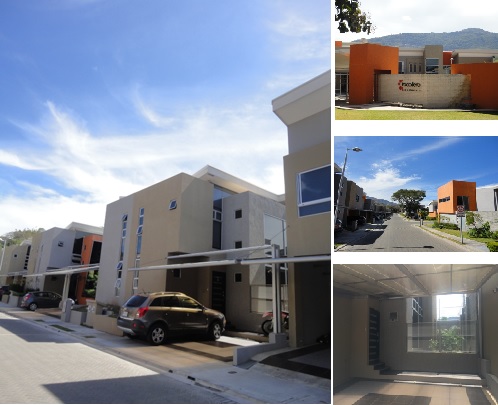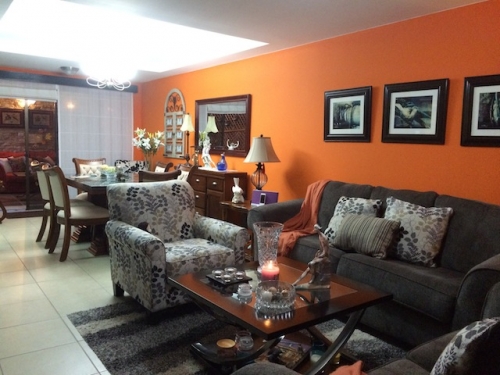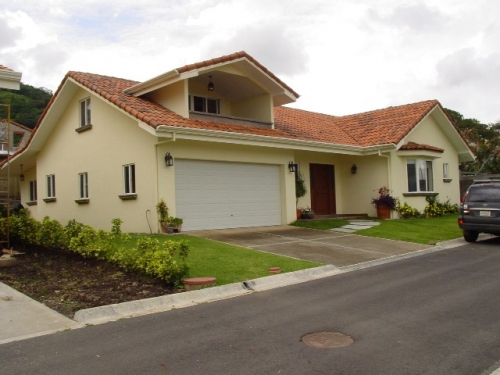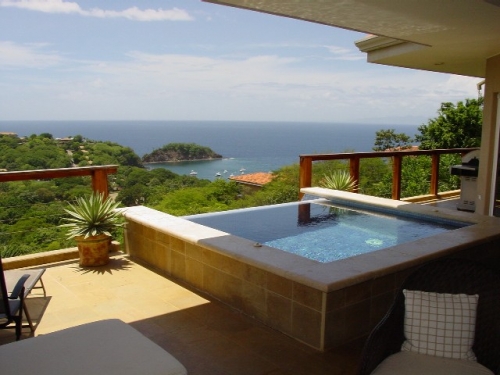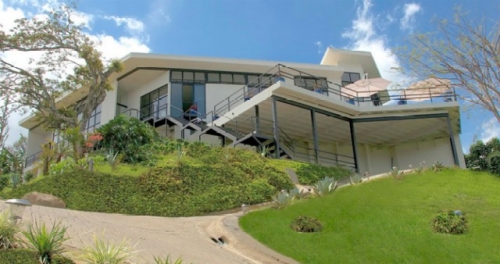Costa Rica Guide
Costa Rica Real Estate
List your property today!
Inclusion of real estate listings at Costa Rica Guide is
absolutely free of charge.
Featured Properties
Costa Rica Guide - Costa Rica Real Estate
Costa Rica's Samara perfect hideaway
James Beck
The Post and Courier
July 21, 2002
Costa Rica's diverse landscape adds to this small Central American country's charm. While its mountains offer crisp air and comforting temperatures, its nearby coast provides a tropical setting, coconut and mango trees lining isolated, nearly private coves on the Pacific Ocean.
The Pacific Coast is a true tropical paradise and the tiny beach community of Samara is one of its treasures.
Samara is a hideaway that is still largely undiscovered by American tourists, except for a small band of surfers. Located halfway down the Nicoya Peninsula, Samara is a four-hour trip from the capital city of San Jose, including a wait for a busy ferryboat that connects the mainland to the peninsula at Rio Tempisque. It is this ferry that plays such a major role in protecting Samara's remoteness.
But the 15-minute ferry ride offers a glimpse of the future, one that likely will invade Samara's privacy. To the north looms a new bridge that is scheduled to open later this year and will cut hours from the trip to paradise.
Coming down from the mountains of Monteverde and across the ferry to the Nicoya Peninsula and Samara is a 61/2-hour trip. After two hours of some of the worst roads in civilization, the road changes drastically into a smooth, paved one, although at times a bit narrow.
The turnoff to the ferry is only a short distance away once you reach the Pan American Highway. The restaurant opposite the turnoff does good business when the sign goes up warning motorists that the ferry is out of order, as it was on the late June day we headed for Samara. But after a break for lunch, the sign came down, causing our driver to celebrate. He had just saved two hours of extra driving.
Samara is less than two hours from the ferry crossing, even taking time to stop while cowboys herd cattle down the paved road. Samara is worth the trip. It's a true jewel of the South Pacific.
Hotel Las Brisas is a key destination for the Samara tourist. Not only is it a first-class hotel by American standards, it is the only air-conditioned hotel on the beachfront overlooking the Pacific. And in this tropical setting where lizards, crabs, spiders and snakes, even iguanas, search for openings into man's domain, the sound of the window air conditioner against the roar of the ocean's huge waves is comforting.
As the warm sunlight floods through the windows, 5 a.m. is the perfect time to start your day. The hotel's open-air beachfront restaurant begins service in an hour. Fruit, picked from the mango and papaya trees that are everywhere, is a popular breakfast item, along with coffee, orange juice, toast, and even bacon and fried eggs.
By the time breakfast ends, the beach is heating up from a sun that already feels like our midday version. And late June is the off-season, or the beginning of the rainy season (mid-December through April is the dry season). Rain often falls once a day this time of year, but within an hour the sky is usually clear and the sun's rays are burning again. Mornings are primetime and long. Afternoons are short.
You can stroll the three-kilometer beach of the cove, enjoying warm-water flats created on the south end of the cove by waves, rock beds and the sun. Shells are plentiful. Or if your group includes teen-age girls, sunbathing is essential, all hours of the day. Or you might book one of the reasonably priced ocean trips for a day of fishing in the Pacific or go snorkeling in the shallow reefs near the mouth of the cove.
California transplant Jesse Dicker's surfing shop is located a couple hundred yards north of the hotel. He will provide an hour of expert surfing lessons for $20.
A hundred yards farther is the beach entrance to the town. Once there, first stop is the all-important supermarket where a gallon of bottled water can be purchased for a little more than 500 colones, about $1.50 in U.S. dollars. Next to the supermarket is the town's most thriving business, a two-computer Internet stop. Four hundred colones (the conversion rate is anywhere between 350 to 360 colones to a dollar) will buy you 15 minutes of web-surfing time, just enough time to check out Wimbledon and the status of the U.S. financial markets, while leaving some time to send e-mails to friends back home.
After a few days in Samara, our driver arrives at 9 a.m. to take his party of four on the 61/2-hour trip across the Tempisque Ferry, south past tourist Mecca Jaco and fishing town Quepos to bustling beach town Manuel Antonio. This time, the ferry is working fine, but the line of cars, buses and trucks is long. The wait is about an hour. Fortunately, there's a row of open-air restaurants and bars. Near one of them, a man is tending to tempting chicken shish-kabobs on an open-fire grill. We pass and instead purchase bottled water and drinks. The next hottest items here are the bathrooms at a cost of 100 colones.
Once we cross the Tempisque River, it's only a short trip down the coast near Jaco before our driver stops at a bridge for us to observe a dozen or so huge crocodiles lining the north bank of a river that empties into the Pacific.
After Jaco, the road deteriorates around bridges. The road is still paved, but for some reason the pavement on each side of the many bridges is usually interrupted for approximately 100 yards of mud and potholes. But this is nothing like Monteverde.
We turn inland slightly in Quepos, a fishing village and port whose main street runs alongside the bay where fishing boats and sailing vessels are anchored. The sunset here over the bay and fishing boats is awesome. Seafood restaurants abound.
The five miles from Quepos to Manuel Antonio are full of mountain twists and turns, as little red taxis dart in and out around slower trucks and buses.
Most visitors to Costa Rica pay a call on Manuel Antonio. It's known for its beaches, wildlife, national park and cloud forest and there is a good selection of hotels.
On our second day at the Hotel Costa Verde, we ran into a group from Charleston, including 11 students and two teachers from Wando High School, led by Wando marine science teacher Julie Cliff.
The hotel is located on a hill on the hotel-lined road that ends in the village of Manuel Antonio where a tidal creek serves as an exterior fence to Manuel Antonio National Park. The hotel, even with its gorgeous views of the Pacific from its large rooms, is Americanized. No phones, but cable TV is a feature of its high-quality rooms. The staff is bilingual.
The Costa Verde has three restaurants, including El Avion which is carved out of an old airplane; La Cantina, which is an outdoor wood-burning barbecue grill that surrounds a cable car that houses an Internet shop; and the Anaconda, the property's main restaurant featuring tiny squirrel monkeys playing in the surrounding trees.
The only inconvenience is that the beach is about a half mile down the mountain from the hotel. The walk down is relatively easy, but even the hot, muggy bus is a welcome sight when it's time to head back to the hotel. The bus ride costs 90 colones (about a quarter), whether you're stopping at your hotel or going all the way to Quepos.
The public beach is free, but the prime beaches are inside the jungle-like Manuel Antonio Park where you might see monkeys, snakes or sloths on the 500-yard walk from the entrance to the near-perfect, pool-like beach No. 3. There is a $7 per person fee for park entry.
The mountain-winding trip from Manuel Antonio back to San Jose to catch an airplane home takes about four hours.
Our 15 days in Costa Rica amounted to a perfect vacation. There was no absence of friendliness from the people of this Spanish-speaking, no-military country that is a model for a peaceful world. Language wasn't a barrier, even with taxi drivers who weren't always proficient in English.
Costa Ricans show Americans no agenda or hostilities, only smiles.
Copyright 2002 The Post and Courier.
Note: The above information is not to be used for any other purpose other than private study, research, criticism or review. Thank you.

